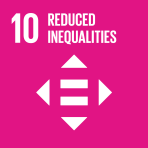 Reduced Inequalities
Reduced Inequalities
Derara’s story from Ethiopia
Derara, 7, plays on the sun-scorched ground in Dubuluk camp for displaced persons in southern Ethiopia. His laughter rises above the stillness of the camp, which is lined with makeshift shelters. A heavy sense of uncertainty lingers but, for Derara, a sense of normality is slowly returning.
Astride’s story from the Democratic Republic of the Congo
“I lost five years of schooling to the mines. But through welding I gained strength and independence,” explains Astride, 16, as she examines a window frame she has just finished welding.
Regional classifications
Aggregates presented at the end of each of the 19 statistical tables are calculated using data from countries and areas as classifiedbelow.
Youth visions: Poverty-free futures
How do children and young people experience poverty? This chapter articulates young people’s experiences: The challenges they must confront and the futures they dare to shape.
Kulsum’s story from Bangladesh
Fourteen-year-old Kulsum sits cross-legged on the floor of a makeshift bamboo classroom in Cox’s Bazar, Bangladesh. Around her, the walls are adorned with colourful teaching and learning aids in Burmese and English. After three months off, she is finally back in class.
Sylvia’s story from Bulgaria
In April 2021, social worker Katya Kirova was making the rounds in the Roma community of the Meden Rudnik neighbourhood in Burgas, Bulgaria, when she came across a child who showed signs of developmental delay.
Proven ways to reduce child poverty
What drives reductions in child poverty? Evidence from countries that have achieved significant progress points to five key policy pillars that, when implemented together, can deliver lasting change.
Foreword
Astride was 12 years old when tuberculosis threatened her family’s future.
Antini’s story from the United Republic of Tanzania
Squeezed into a narrow market stall in Kigoma Region, 17-year-old Antini is busy stitching clothes.
Sawsan’s story from Lebanon
It was October 2024. Sawsan, then aged 6, was playing outside her home with friends when an airstrike hit her neighbourhood in the Beqaa Valley, eastern Lebanon.
Child poverty today
At its core, poverty is a lack of financial resources. This alone does not capture the full reality for children.
Child mortality estimates
Under-five mortality is used as the principal indicator of progress in child well- being. Here are under-five mortality rates and deathsby UNICEF region.
Ompfuna’s story from South Africa
Ompfuna, 10, rides her yellow scooter along a narrow footpath outside her house in Silvertown, near Alexandra township in South Africa. Her home is less than 20m away from the Jukskei River’s edge, and she’s careful not to ride too close to the steep bank.
Conclusion
In so many areas, we already know what needs to be done to combat child poverty. And we have the foresight and experience to do more to tackle our future challenges.
